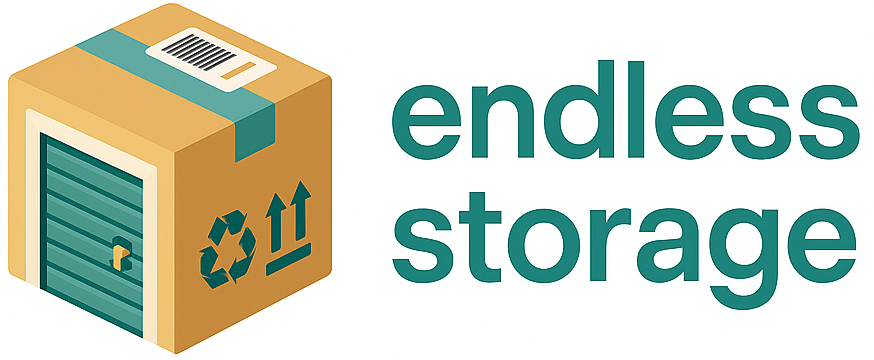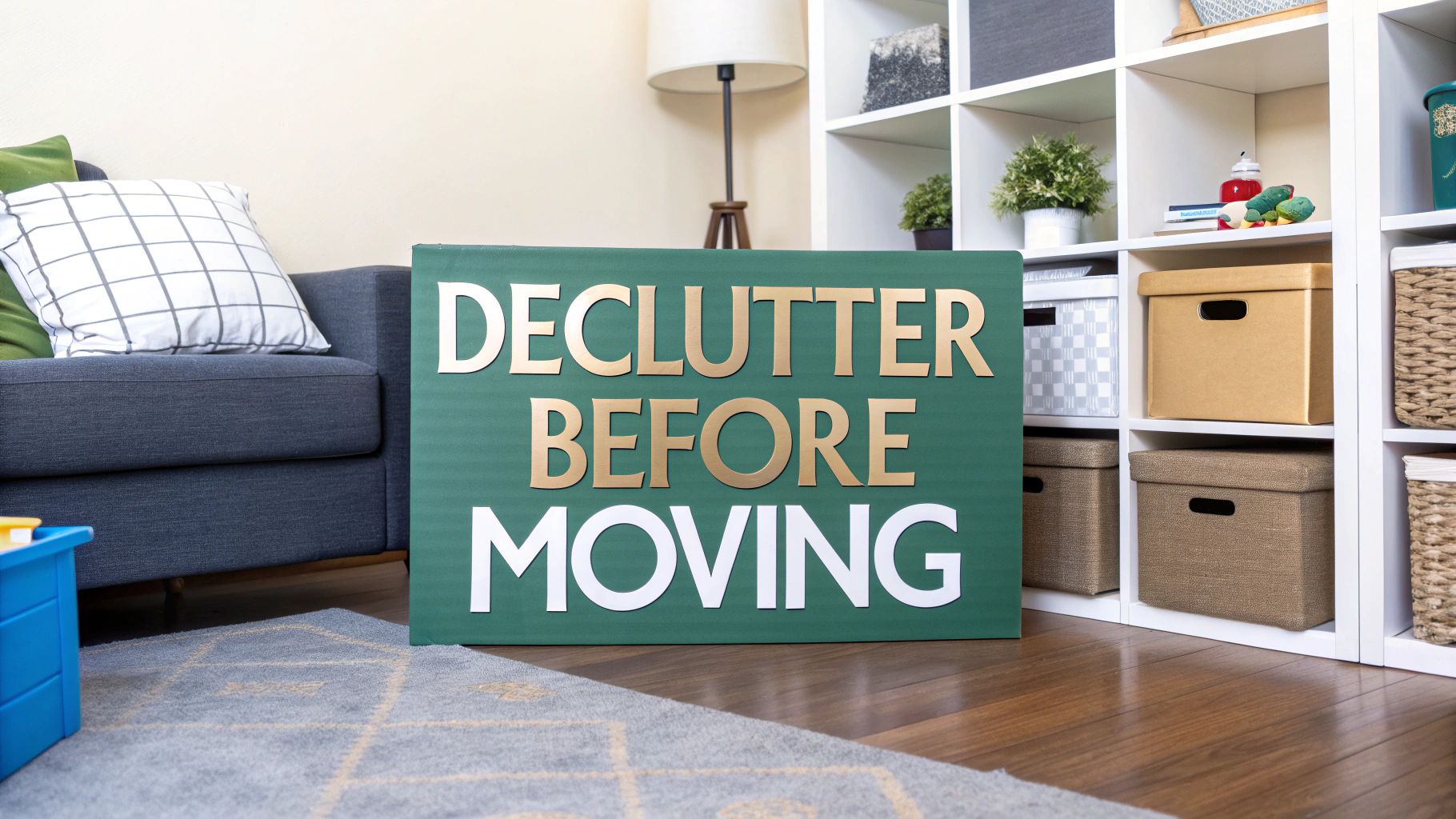Moving is often cited as one of life's most stressful events, but much of that anxiety can be eliminated before the first box is even packed. The secret is to declutter before moving, a crucial step that transforms the entire experience. Systematically deciding what to keep, sell, donate, or discard is the single most impactful action you can take for a smoother, more efficient, and less expensive relocation. A well-executed purge means you're not paying to move items you no longer need, saving you time, money, and energy on both ends of your journey. For those undertaking a significant lifestyle change, a resource like this comprehensive Downsizing In Dallas Guide can provide targeted local advice.
This guide provides a structured framework to conquer the chaos. We will detail eight distinct and actionable methods, moving beyond generic advice to give you practical strategies you can implement immediately. From the tactical Three-Box Method to a strategic 6-8 week timeline, you will find a system that fits your schedule and personality. This process isn't just about getting rid of stuff; it's about curating the life you want to live in your new home. For those treasured items that don’t fit your new space but you can’t bear to part with, a flexible solution like Endless Storage can be a strategic asset, bridging the gap between your past and future. Let's dive into the techniques that will streamline your move.
1. The Room-by-Room Approach
Tackling your entire home at once is a surefire way to feel overwhelmed. The room-by-room approach is a systematic decluttering method that breaks down the monumental task of preparing for a move into manageable, focused sessions. By concentrating on one space at a time, you can make more thoughtful decisions about what to keep, toss, or donate, ensuring you only pack what you truly need and love.
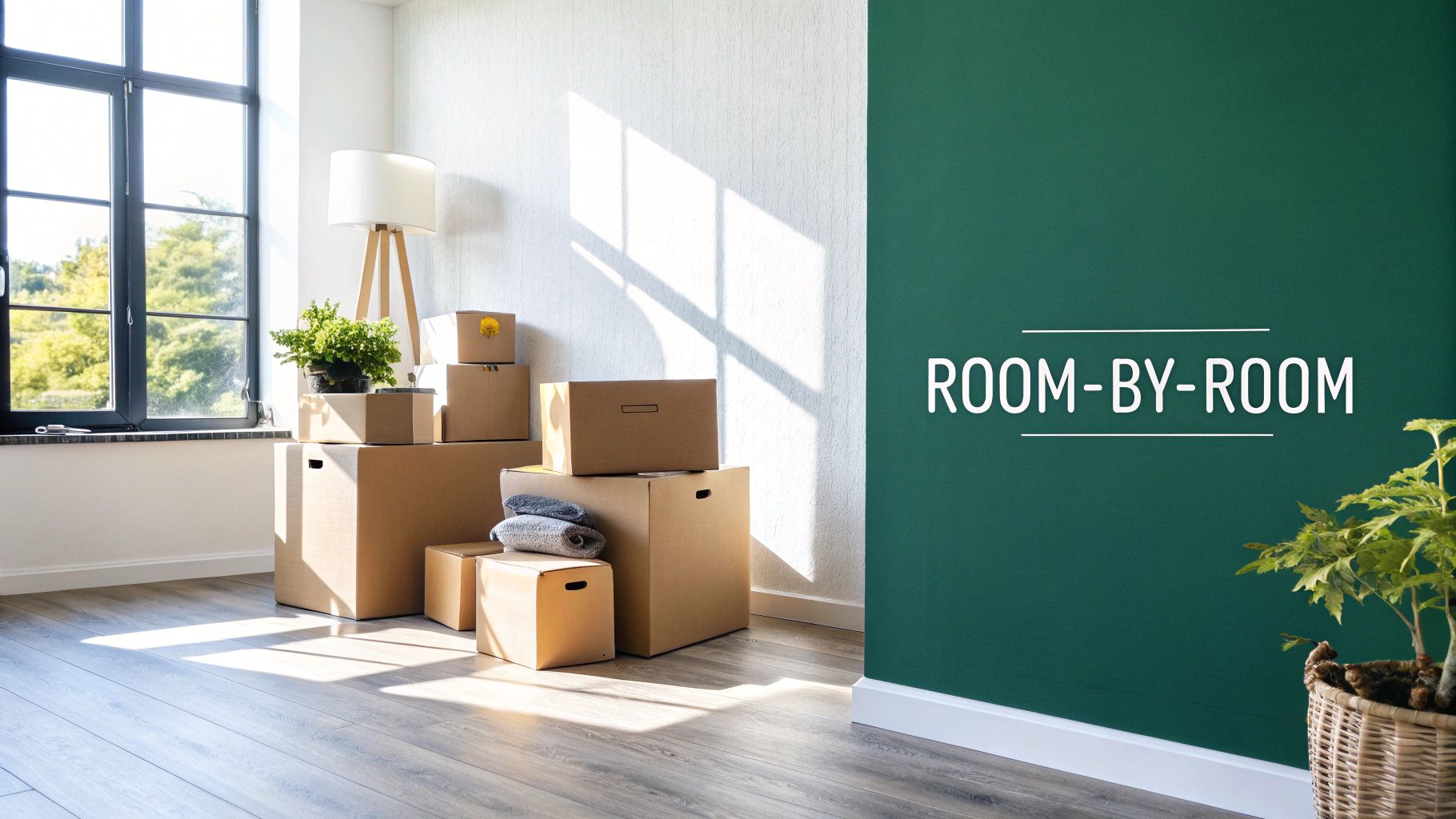
This strategy prevents burnout and provides a clear sense of accomplishment as you complete each area. Professional organizers, including Peter Walsh and Marie Kondo, often use this principle to guide clients, dedicating specific time blocks to conquer one room before moving to the next.
How to Implement This Method
To effectively declutter before moving using this strategy, start with a clear plan. Begin with the least emotionally taxing room, such as a guest bathroom or laundry room, to build momentum and confidence. From there, create a logical sequence for the rest of your home.
- Set a Timeline: Allocate specific days or weekends to each room. For instance, tackle the kitchen one Saturday and the primary bedroom the next.
- Prepare Your Supplies: Before you start a room, gather boxes or bins labeled "Keep," "Donate," "Sell," and "Trash."
- Be Thorough: The goal is to touch every single item in the room. Pull everything out of closets, drawers, and cabinets. This approach helps you reassess items you might otherwise overlook and is a great time to consult an ultimate guide to closet organization systems to plan for better storage in your new space.
By following a structured plan, such as the one found in an apartment moving checklist, you can ensure no area is forgotten. Creating a visual roadmap of your progress can be incredibly motivating. For a more detailed timeline, you can get additional insights from our comprehensive apartment moving checklist.
2. The Three-Box Method
One of the biggest hurdles when you declutter before moving is decision fatigue. The Three-Box Method simplifies choices by forcing you to categorize every single item you own into one of three distinct containers: Keep, Donate/Sell, or Trash. This practical sorting system eliminates the dreaded "maybe" pile, ensuring every object is assigned a clear, final destination.
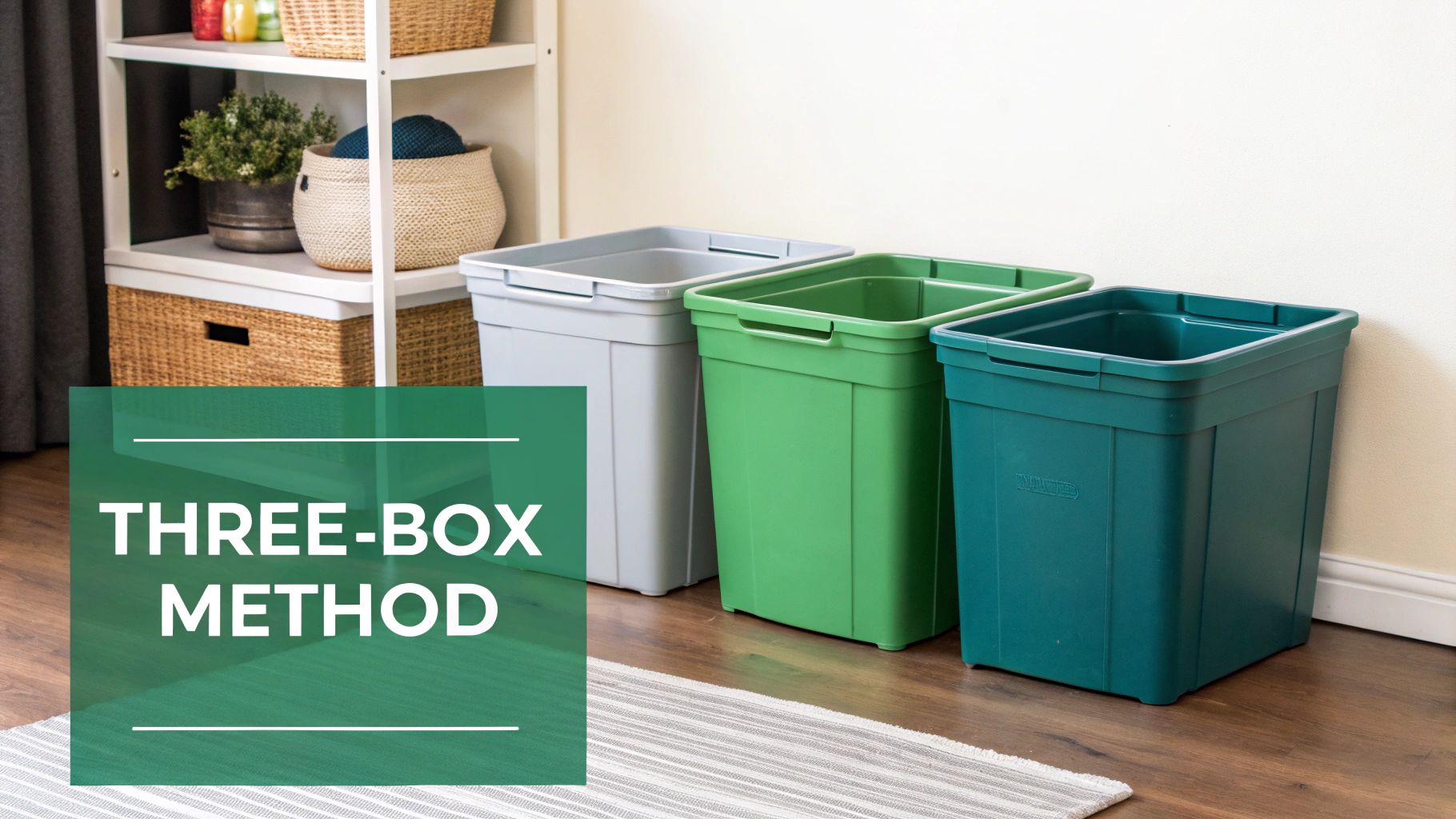
Popularized by professional organizers like Julie Morgenstern and featured extensively on reality TV organizing shows, this method streamlines the entire decluttering process. It transforms an emotionally draining task into a logical, assembly-line-style operation, making it easier to part with items that no longer serve you and reducing what you'll need to pack and move.
How to Implement This Method
The effectiveness of this strategy lies in its simplicity and your commitment to making quick, definitive choices. The goal is to handle each item only once, assess its value, and immediately place it in the appropriate box without second-guessing.
- Gather Your Bins: Before starting, get three physical boxes or large bins and clearly label them "Keep," "Donate/Sell," and "Trash." Using actual containers instead of mental categories is crucial for success.
- Apply the One-Touch Rule: Pick up an item and make an immediate decision. If it’s something you use, love, and need in your new home, it goes in the Keep box. If it's in good condition but you no longer need it, it goes in the Donate/Sell box. If it's broken, expired, or unusable, it goes in the Trash box.
- Work Systematically: Use this method as you go through closets, drawers, and cabinets. For example, when decluttering your kitchen, that unused novelty gadget goes to Donate/Sell, the chipped mug goes to Trash, and your favorite cast-iron skillet goes to Keep.
This straightforward approach accelerates your decluttering efforts, helping you clear out spaces efficiently. Once the "Keep" box is full, you can tape it up and label it for the move, giving you a tangible sense of progress.
3. The 6-8 Week Timeline Strategy
Procrastination is the enemy of a stress-free move. The 6-8 Week Timeline Strategy is a structured approach that spreads the decluttering process over nearly two months, giving you ample time for thoughtful decision-making without the pressure of last-minute chaos. This method accounts for the emotional energy decluttering requires, the logistics of selling or donating items, and coordinating with movers.
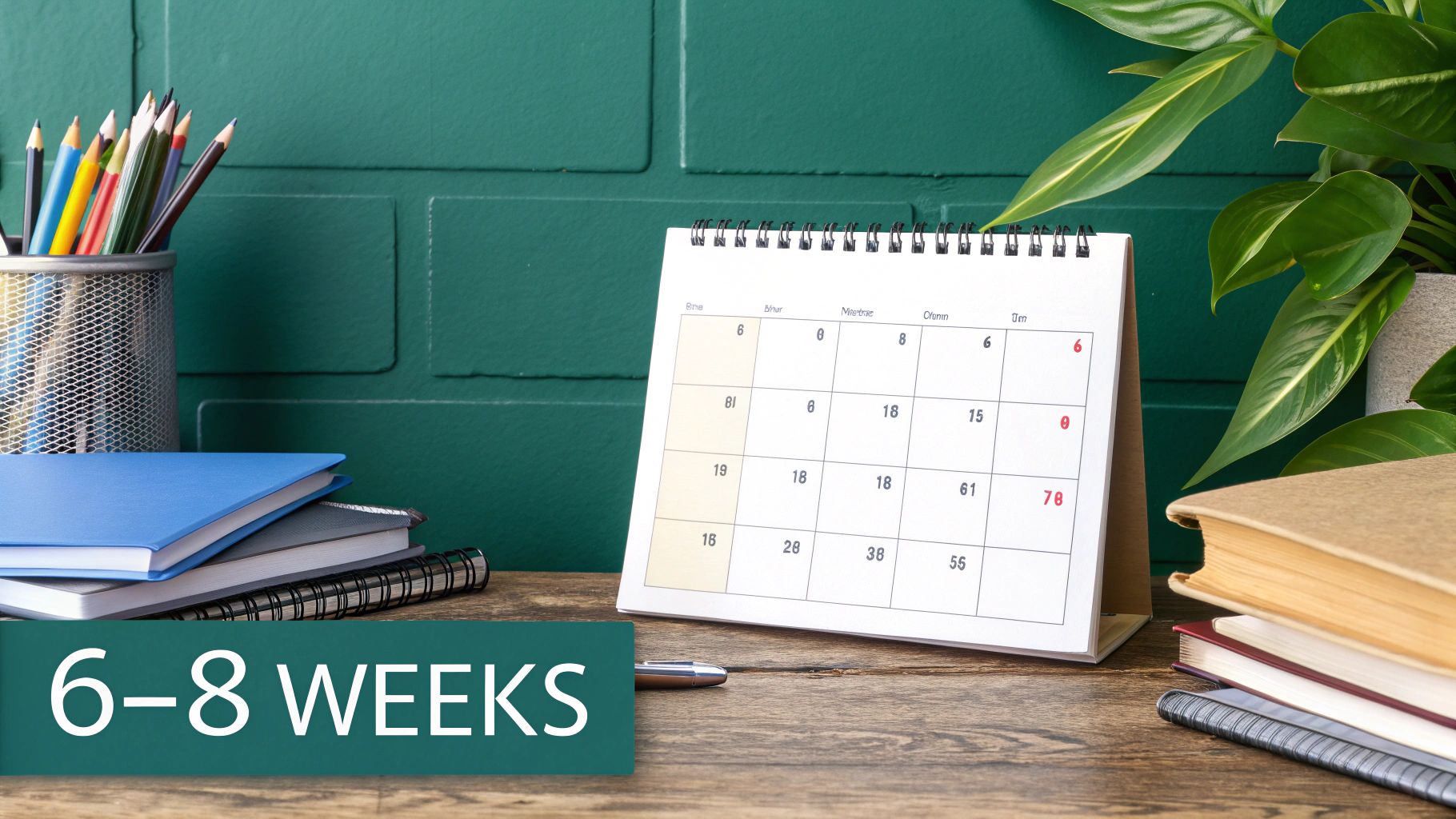
This extended timeframe transforms the monumental chore of sorting your life's possessions into a series of manageable weekly goals. By starting early, you can avoid rushed choices you might later regret and ensure you only move items that add value to your new life. It's the ultimate method to declutter before moving without feeling overwhelmed.
How to Implement This Method
Success with this strategy hinges on creating and sticking to a detailed calendar. Breaking down tasks by week prevents you from falling behind and allows you to methodically work through your home, ensuring nothing is overlooked.
- Weeks 1-2: Plan and Research. Start by assessing your new home's layout and storage. Research community donation centers and online selling platforms for valuable items.
- Weeks 3-4: Tackle Living Areas. Begin decluttering high-traffic spaces like the living room, dining room, and bedrooms. This is often where you'll see the most immediate impact.
- Weeks 5-6: Focus on Storage Zones. Move on to the areas where clutter accumulates most: the garage, basement, attic, and closets. These spaces often require more time and effort.
- Weeks 7-8: Final Sort and Pack. Address any remaining small areas, finalize donation pickups, and begin packing the items you've decided to keep.
This timeline provides a clear roadmap, reducing move-related anxiety by giving every task its own dedicated time slot. To build a robust plan, you can discover more about creating an effective timeline by reading our guide on decluttering before moving.
4. The 'Will I Use This in My New Home?' Test
Moving is not just about changing your address; it's about starting a new chapter. The 'Will I Use This in My New Home?' test is a powerful decision-making framework that forces you to evaluate items based on your future life, not your past. Instead of clinging to possessions out of habit or sentiment, this method helps you declutter before moving by focusing on relevance and practicality for your new environment.
This forward-thinking approach is especially effective for major life transitions like downsizing, relocating to a different climate, or moving from a house to an apartment. It shifts your mindset from "what do I own?" to "what will I actually need and use?" This ensures you don't waste time, money, and energy packing, moving, and storing items that no longer serve a purpose.
How to Implement This Method
Applying this test requires a bit of research and visualization. You need to understand your new space and lifestyle to make informed decisions. For example, that bulky set of winter coats has no place in a tropical climate, and extensive gardening tools are useless if you're moving to an apartment with no yard.
- Analyze Your New Space: Get a copy of your new home's floor plan. Measure rooms and potential storage areas. This will help you realistically assess whether your oversized sofa or large dining table will even fit, let alone look good.
- Consider Your Future Lifestyle: Think about how your daily routines will change. If you're moving closer to a vibrant restaurant scene, will you still need every specialized kitchen gadget? If your new building has a state-of-the-art gym, is it time to part with that dusty treadmill?
- Factor in Climate and Community: Research the climate of your new location to determine which clothing and seasonal items are necessary. Also, consider nearby amenities. If a library is just a block away, you might not need to haul every book you own across the country.
By asking this simple yet profound question for every item, you curate a collection of belongings that perfectly aligns with your new life. If an item doesn't pass the test, it's time to sell, donate, or responsibly dispose of it. If you have items you're unsure about but can't part with, consider a flexible storage solution as a temporary hold-over while you settle in.
5. The One-Year Rule
The “just in case” mentality is one of the biggest obstacles to effective decluttering. The One-Year Rule is a powerful and practical guideline designed to overcome this hurdle. It provides a simple yet effective filter for decision-making: if you haven't used an item in the past twelve months, it’s a strong candidate for donation, sale, or disposal.
This method forces an honest assessment of what you genuinely need versus what you think you might need one day. It accounts for seasonal variations and annual cycles, making it particularly effective for categories like clothing, kitchen gadgets, and hobby supplies. By setting a clear, logical timeframe, you can streamline the process and declutter before moving with confidence, ensuring you don't pay to transport items that serve no purpose.
How to Implement This Method
Applying the One-Year Rule requires a disciplined approach, but it simplifies countless decisions. As you sort through your belongings, ask yourself a straightforward question: “Have I used this in the last 365 days?”
- Be Honest and Realistic: That bread maker you bought with good intentions but haven't touched since last winter or the stack of books you planned to read but remain unopened are prime examples. If the answer is no, it's time to let them go.
- Account for Seasonality: This rule works well for seasonal items. If you didn't use specific holiday decorations last Christmas or wear a particular winter coat all season, it’s a sign it's no longer needed.
- Make Logical Exceptions: The rule isn't absolute. Keep important documents, emergency supplies, high-value sentimental items, and essential tools, even if they aren't used annually.
- Consider Replacement Cost: For an item you're unsure about, consider its replacement cost. If it’s inexpensive and easily replaceable, letting it go is a low-risk decision. For more valuable or hard-to-find items, you might consider keeping them, but if space is tight, a temporary storage solution could be a better fit.
6. The Sentimental Item Strategy
Few things can halt the decluttering process faster than stumbling upon a box of old photographs, children's artwork, or inherited keepsakes. The Sentimental Item Strategy is a specialized approach for handling these emotionally significant possessions, which often paralyze decision-making. This method acknowledges your emotional attachment while keeping you focused on the practical goal of preparing for your move.
Instead of getting bogged down, this strategy involves isolating sentimental items and addressing them with a clear, predefined plan. By creating specific limits and using creative preservation techniques, you can honor your memories without transporting boxes of items that may no longer serve a purpose in your new home. This is a crucial step to declutter before moving effectively, as emotions are often the biggest obstacle.
How to Implement This Method
The key to this strategy is separating the emotion from the initial, broader decluttering effort. Save sentimental items for last, when your decision-making "muscle" is warmed up and you're in a more pragmatic mindset. This prevents emotional fatigue from derailing your progress in more straightforward categories like kitchenware or linens.
- Set a Physical Limit: Designate one or two "memory boxes" of a specific size. This forces you to be selective and keep only the most meaningful items that will fit.
- Digitize and Photograph: You don't need the physical object to preserve the memory. Take high-quality photos of bulky items like children's art projects or collections. Digitize old letters, cards, and photos to create a digital archive that takes up zero physical space.
- Choose a Representative Item: From a larger collection, such as your grandmother's china or a box of your old sports trophies, select just one or two representative pieces to display. You can then offer the rest to other family members who might cherish them.
By applying a structured approach, you can make thoughtful choices without guilt. For a more in-depth guide, you can learn more about our specialized sentimental item strategy on endless-storage.com.
7. The Sell vs. Donate Decision Matrix
When decluttering before a move, deciding what to do with unwanted items can be a challenge. The Sell vs. Donate Decision Matrix is a systematic approach that helps you determine whether an item is worth selling for profit or better off donated for convenience and potential tax benefits. This method evaluates an item's value, condition, and market demand against the time and effort required to sell it, ensuring you make the most practical choice.
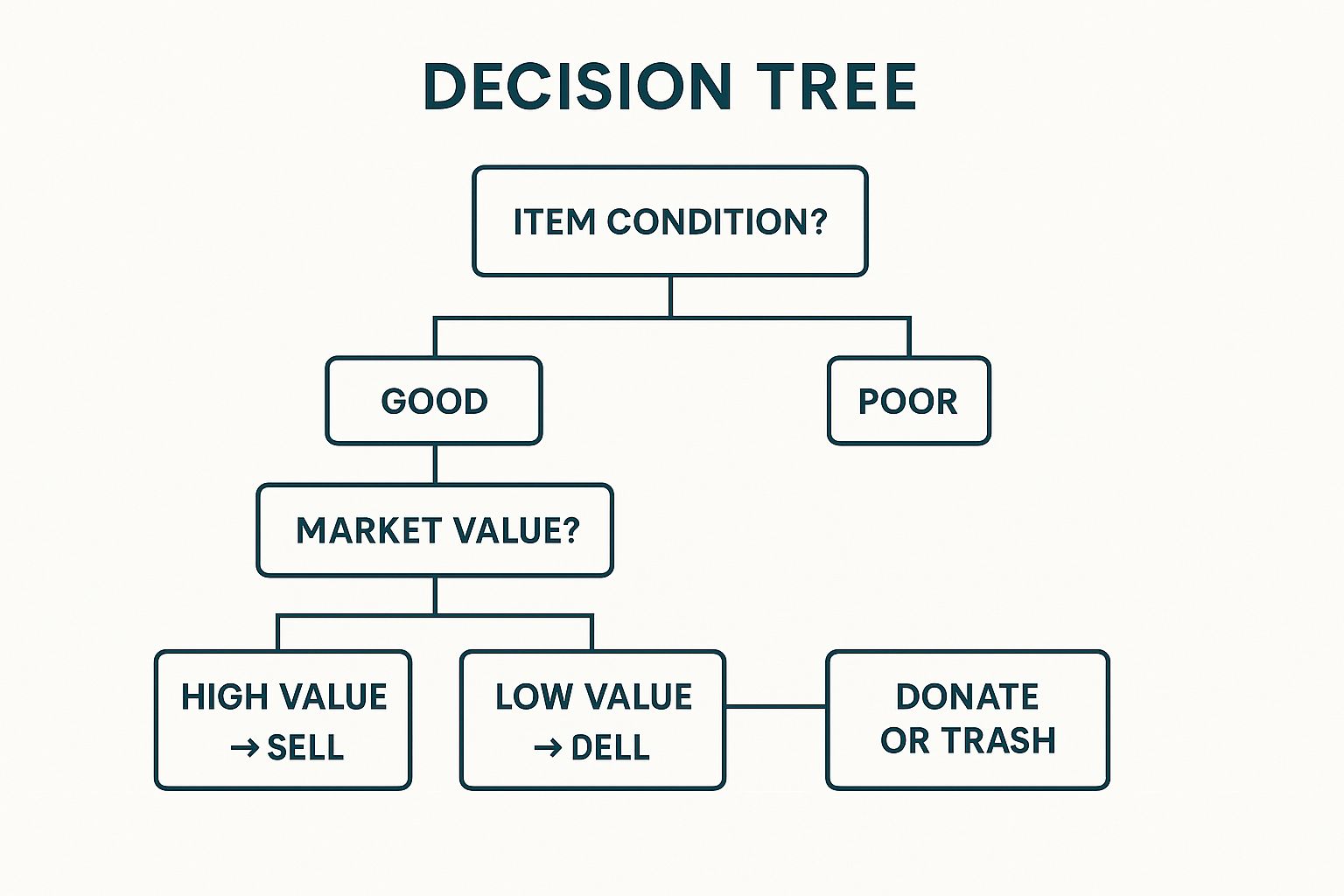
This strategy empowers you to maximize the financial and practical outcomes of decluttering. By creating clear criteria, you avoid emotional decision-making and focus on what provides the most value, whether that's cash in your pocket or a quick, hassle-free removal. This process is especially useful for those with a mix of high-value and everyday items.
How to Implement This Method
To effectively use the decision matrix, you need to be objective about your belongings and your available time. Start by grouping similar items together, like electronics or clothing, to assess them more efficiently. Remember, the goal is to streamline your move, not to start a new side business.
- Set a Value Threshold: Decide on a minimum price that makes selling worthwhile for you, for example, anything you believe you can sell for over $50. Items below this threshold are automatically slated for donation.
- Research Market Demand: Quickly search for similar items on platforms like Facebook Marketplace, eBay, or Poshmark to gauge their current resale value. High-demand items like recent electronics, designer clothing, or well-maintained furniture are strong candidates for selling.
- Factor in Your Time: Be realistic about the effort involved in photographing, listing, and shipping or meeting buyers. If the time investment outweighs the potential profit, donating is the more efficient choice. A detailed guide can help you further explore how to decide what to keep and what to sell when moving.
8. The Pre-Move Inventory System
Creating an inventory is a powerful documentation method that gives you a comprehensive record of your belongings before, during, and after you declutter before moving. This system involves cataloging items by room and destination (keep, sell, donate, or trash), often using digital tools like spreadsheets or apps. It’s an organizational powerhouse that does more than just track your stuff; it helps prevent loss, streamlines coordination with movers, and provides critical records for insurance claims or potential tax deductions.
This methodical approach transforms the chaos of sorting into a structured project. By documenting every decision, you create an authoritative list that ensures valuable items aren't accidentally discarded and that your movers know exactly what they're transporting. It also provides a clear, satisfying visual of your decluttering progress.
How to Implement This Method
A pre-move inventory system brings clarity and control to your decluttering efforts. The key is to choose a format that works for you and to be consistent in updating it as you make decisions on each item. This documentation becomes your single source of truth throughout the move.
- Choose Your Tool: Start with a simple spreadsheet with columns for room, item, condition, and its final destination. Alternatively, use apps like Sortly or a photo inventory where you can tag and categorize images of your belongings.
- Document as You Go: Integrate the inventory process directly into your decluttering sessions. As you decide the fate of an item, immediately log it in your system. This real-time updating prevents you from having to do it all at once later.
- Add Detail for Valuables: For high-value items like electronics, art, or furniture, take clear photos and note serial numbers and their condition. This documentation is invaluable for insurance purposes should anything get damaged or lost.
Creating an inventory doesn't have to be complicated. To get started quickly and efficiently, you can download a pre-made template. For a great example, check out our comprehensive home inventory checklist template to simplify your record-keeping.
8 Decluttering Methods Compared
From Clutter to Clarity: Your Next Chapter Starts Now
Moving is more than a physical relocation; it's a profound opportunity to reset your life, and that reset begins with what you choose to bring with you. By tackling the task to declutter before moving, you are actively curating the environment of your future. You are not just emptying drawers and closets; you are making intentional decisions that will define your new space, reduce moving day stress, and significantly cut down on the time and cost associated with transporting your belongings.
The strategies we've explored, from the systematic Room-by-Room Approach to the decisive One-Year Rule, are not just about getting rid of things. They are powerful tools designed to bring clarity to your life. The ultimate goal is to transform what feels like an overwhelming mountain of possessions into a manageable, organized collection of items you genuinely need, use, and love. This process empowers you to step into your new home feeling lighter, more in control, and ready to embrace your next chapter without the weight of past clutter.
Key Takeaways for a Streamlined Move
As you embark on this journey, remember these core principles to guide your decisions and keep you motivated:
- Start Early, Work Small: The 6-8 Week Timeline is your best friend. Procrastination is the enemy of a calm move. Breaking the process down into manageable, bite-sized tasks prevents burnout and ensures you make thoughtful, not rushed, choices.
- Be Ruthlessly Honest: The 'Will I Use This in My New Home?' Test is your most critical filter. Your new space has different dimensions, a different layout, and perhaps a different style. Be realistic about what will actually fit and function in your future life, not just your past one.
- Create Definitive Categories: The Three-Box Method (Keep, Donate/Sell, Discard) is non-negotiable for creating momentum. It eliminates indecision by forcing a clear path for every single item you touch, preventing the dreaded "maybe" pile from taking over.
- Embrace the In-Between: Not every item fits neatly into a "keep" or "discard" box. For valuable heirlooms, seasonal gear, or important documents that you don't need immediately but can't part with, a third option is essential. This is where strategic storage becomes a game-changer.
Ultimately, the effort you invest to declutter before moving pays dividends long after the last box is unpacked. It establishes new habits of mindfulness and organization, making it easier to maintain a tidy and serene living space from day one. You're not just moving your stuff; you're moving your life forward with purpose and intention.
Ready to make your move simpler and smarter? For those cherished items that need a safe place during your transition, let Endless Storage be your solution. We provide by-the-box storage with pickup and delivery, giving your belongings a secure home until you're ready for them. Visit Endless Storage to see how we can help you declutter with confidence and start your next chapter with ease.
Frequently Asked Questions
Unveiling the Secrets to Effortless Storage
Endless Storage is available nationwide. You pick a plan, tell us where to pickup, and we'll send a UPS van to collect, whichever state you're in.
Your shipping label will be sent to your email within a few minutes, if not instantaneously. It can also be accessed through your customer profile.
Your box will be shipped to one of our climate controlled self storage facilities in our closest self storage facility. Our manager will accept your package, notify you that your box has been received, and securely stored. Only our managers will have access to Endless Storage boxes.
Email us at admin@endless-storage.com click to live chat with us, or send us a message below.
Never! We're committed to transparent pricing with no surprises. You'll lock in your rate with no hidden fees and no long-term contracts.
Fast access guaranteed! Your boxes will arrive at your doorstep within 48 hours of requesting them back. Need to check on delivery? We provide tracking information for complete peace of mind.
Totally flexible! Store month-to-month with no long-term commitment and cancel anytime.
Everything's online! Use your account dashboard to:
• Set up automatic monthly payments
• Request box returns
• Update your address
• Order additional boxes
• Track shipments
Your boxes are insured up to $100 each. Our customer service team will help you file any necessary claims and resolve issues quickly.
Don't worry – we'll email you right away if there's a payment issue. Your items stay safe, though you may have temporary service interruption or late fees until payment is resolved.
When you request our free storage kits, you'll have 30 days to send in your boxes to activate your 3 months of free storage. Think of it like starting a gym membership – your activation window begins when you receive your kits, and your full free trial begins once you send in your first box. During your free months, you'll experience our complete storage service at no cost.
Your 30-day activation window begins when you receive your storage kits. We'll send you an email confirmation when your kits are delivered, marking the start of your activation period.
If you haven't sent any boxes for storage within your 30-day activation window, your free trial will expire and we'll begin charging the regular monthly rate of $9.99 per box. This helps ensure our storage kits go to customers who are ready to use our service.
A box costs $9.99 per month to store (plus sales tax). This price includes free shipping for standard boxes under 50 lbs. and smaller than 16"x16"x16"
Log into your Endless Storage account, locate the box you would like returned, and simply click Return My Box.
Yes, each box stored with us is insured for up to $100 throughout transit as well as the duration of storage within our facilities.
Your box will be at your doorstep within 48 hours of you requesting it back.
Store 10+ boxes? We'll pick them up for free! After your purchase, we'll contact you to schedule a convenient pickup time and arrange UPS collection.
We trust UPS with all shipments, and every box includes $100 insurance coverage. You'll receive tracking information to monitor your items' journey.
Yes! Visit any of our locations by appointment. Just bring a photo ID matching your customer profile.
For everyone's safety, we can't store hazardous materials, firearms, or perishables. All items must fit within our standard boxes.
It's easy! Order your storage kit online, and we'll ship it to you within 1-2 business days. Your shipping labels will be emailed instantly and available in your account.
We're here to help! Email us at admin@endless-storage.com, use our live chat, or send us a message through your account.
To cancel your storage service with Endless Storage, please email your cancellation request to admin@endless-storage.com. Our team will process your request within 2 business days and confirm your cancellation via email.
We understand packing takes time. However, to maintain your free trial benefits, you'll need to send at least one box within the 30-day activation window. If you need more time, you can always start with one box to activate your trial and send the rest later. You can always reach out to admin@endless-storage.com if you have any issues or concerns.
When you request our free storage kits, you're starting a 30-day window to begin using our storage service.
To avoid any charges, simply send at least one box for storage within 30 days to activate your 3-month free trial. If you decide not to use our service and don't send any boxes within the 30-day window, a one-time $50 fee will apply to cover the costs of materials and shipping. This helps ensure our storage kits go to customers who are ready to use our service.
Think of it like reserving a hotel room – we're setting aside space and sending specialized packing materials for your use. The fee only applies if you request materials but don't begin storage, similar to a hotel's no-show charge.
